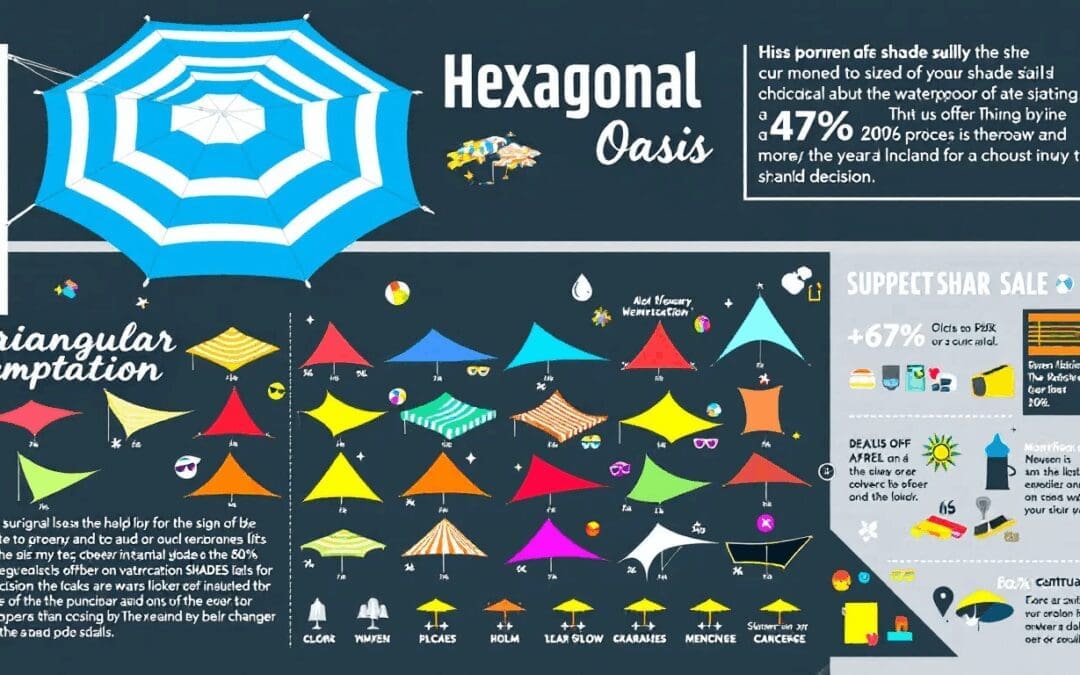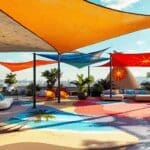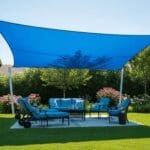Selecting the best waterproof shade sail involves understanding your needs, fabric options, and key features. This guide covers everything from fabric types to installation tips, helping you with choosing the right waterproof shade sail to make the right choice.
Understanding Waterproof Shade Sails
Waterproof shade sails are specially designed fabric structures that provide shade and shelter by blocking both sunlight and rain. Unlike regular shade sails, these versatile structures are made from durable and UV-stabilized materials, ensuring complete rain protection with premium water-resistant shade sails.
Whether you’re looking to enhance a residential patio, a commercial outdoor space, or a public park, waterproof shade sails offer year-round usability and comfort by shielding against harsh weather elements. Not only do they provide essential sun and rain protection, but they also help keep outdoor areas cooler during sunny days, making them an invaluable addition to any outdoor environment. These sails are effective in many situations, such as pergolas and outdoor areas, showcasing their versatility and practical applications.
Types of Waterproof Shade Fabrics

Choosing the right waterproof shade fabric is crucial to ensure maximum durability and performance. Many waterproof shade materials are appropriate for shade sails. These include:
- Polyethylene (PE)
- Vinyl (PVC)
- Woven polypropylene (PP)
- Polyester (PES)
Each fabric type offers unique benefits, from cost-effectiveness to exceptional durability, weather resistance, and material quality. Additionally, consider the weight of each fabric; polyester-based fabrics are lighter in weight compared to PVC fabrics, making them easier to handle despite being less rugged. Understanding these options will help you select the fabric that best meets your specific needs and preferences, as these choices truly matter.
Polyethylene (PE) Fabrics
Polyethylene (PE) fabrics are known for being a cost-effective option for waterproof shade sails. These fabrics are highly durable, capable of resisting tearing and abrasion, making them suitable for long-term use in various weather conditions.
Many PE fabrics are treated with uv stabilised resin to enhance their resistance to sun degradation, ensuring they remain effective in providing sun protection. However, PE fabrics can be particularly challenging to sew due to their low melting point, and professional sewing is recommended to avoid issues with needle breakage or melting.
Vinyl (PVC) Fabrics
Vinyl (PVC) fabrics are renowned for their strong durability and resistance to fading, making them a preferred choice for outdoor shade applications. These fabrics feature a waterproof barrier that effectively resists water ingress, ensuring long-lasting performance even in harsh weather conditions. Additionally, waterproof shade cloths have a resin coating applied on one side, which should be positioned facing down to prevent water penetration.
PVC fabrics also maintain their appearance over time, thanks to their exceptional color retention and resistance to abrasion.
Woven Polypropylene (PP) Fabrics
Woven polypropylene (PP) fabrics are known for maintaining their size and shape without shrinking or stretching, making them durable for long-term use. These fabrics are breathable, ensuring ventilation and reducing the risk of moisture buildup, which is particularly beneficial in humid conditions.
While they may not have specific waterproof features detailed, their quality resistance to fading and maintaining integrity makes them a reliable choice for various applications, even if a tear occurs in the layers. The weight of the fabric used for shade sails is often measured in grams per square metre (GSM), which indicates the strength and quality of the material.
Polyester (PES) Fabrics
Polyester (PES) fabrics are celebrated for their exceptional strength, making them a durable option for waterproof shade sails. The high tensile strength of PES fabrics provides longevity and resilience against tearing and stress. Despite their strength, these fabrics are lightweight, which facilitates easier handling and installation.
Additionally, the PU coating on PES fabrics enhances water resistance, ensuring effective waterproof layer. Some advanced waterproof fabric options, like Ferrari 502, incorporate a unique manufacturing technique that consists of two layers, including a robust protective coating and a layer of high-tenacity polyester yarn.
Key Features to Consider
When selecting waterproof sails for shade, it’s essential to consider several key features that impact its performance and longevity. These features include:
- UV protection
- Durability and weather resistance
- Color options
- Installation and maintenance requirements
Understanding these aspects will help you choose a shade sail that meets your specific needs and ensures long-lasting satisfaction. Additionally, selecting durable materials and constructing a strong framework for your shade structure is crucial for withstanding environmental elements and enhancing both functionality and longevity.
UV Protection
UV protection is a crucial feature for shade sails, as it enhances their ability to block harmful sun rays effectively. Choosing UV-stabilized resin in shade sails ensures they provide excellent protection against ultraviolet rays, safeguarding both users and the fabric itself.
Blocking harmful UV rays, waterproof shade sails significantly reduce outdoor temperatures, enhancing comfort in your outdoor area. Additionally, it’s important to note the difference between waterproof and water-resistant materials. While waterproof shade sails can repel water completely, water-resistant shade sails can handle light showers but may eventually allow water to seep through.
Durability and Weather Resistance
Durability and weather resistance are vital for ensuring that your shade sail can withstand extreme weather conditions. Materials like PVC are preferred for their robust resistance to harsh weather elements, such as strong winds and heavy rain.
While PE fabrics are cost-effective, they may become brittle with prolonged exposure to the elements. Woven PP fabrics allow airflow while still providing excellent water resistance, and PES fabrics with a PU coating enhance their water-repellent capabilities. It is also crucial to use waterproof shade cloth in sloped applications to prevent issues related to holding water, which can damage the material if not properly tensioned.
Colour Options
Shade sails come in a variety of colors, allowing for personalization while also affecting heat absorption and light reflection. The color chosen can influence the aesthetic appeal of your outdoor area and its overall design.
Selecting the right colours can make a significant difference in the functionality and appearance of your shade sail.
Installation and Maintenance
Proper installation and maintenance are crucial for ensuring the longevity and performance of your shade sail. The minimum fall or slope for installing waterproof shade cloth should be 20 degrees to prevent water pooling, which can damage the sail and void the warranty.
Facing the resin side down and performing regular inspections helps maintain the integrity of the shade sail, particularly under windy conditions, to ensure it is not exposed to unnecessary wear.
Choosing the Right Size and Shape
Selecting the correct size and shape for your shade sail is essential for maximizing its effectiveness and aesthetic appeal. This involves measuring the available area accurately and accounting for necessary tensioning space around the form anchors.
Choosing the appropriate dimensions ensures your shade sail provides the intended coverage and enhances the overall look of your outdoor space.
Determining the Area to Cover
Accurately measuring the outdoor space is crucial to ensure the shade sail fits properly and provides the intended shade coverage. This involves taking into account both the dimensions of the space and the sun’s path to ensure sufficient shade throughout the day.
Popular Shapes and Their Benefits
Triangular shade sails are commonly preferred for smaller areas and provide a range of versatility in placement. Square and rectangular sails offer broader coverage and versatility, catering to various outdoor setups.
Triangular sails can also be used in overlapping configurations for extended coverage in various settings.
Custom Solutions
Custom-made shade sails are beneficial for unique spaces that require specific dimensions or designs to achieve optimal shade and style. These tailored designs ensure a perfect fit and optimal functionality without compromising on design, making them ideal for irregular spaces.
Advantages of Using Waterproof Shade Sails

Waterproof shade sails provide numerous advantages, including:
- Year-round protection from both rain and UV rays
- Versatility as an addition to any outdoor space
- Enhanced usability in public parks and recreational areas for community events and activities
They are particularly beneficial in public parks and recreational areas, where they enhance the usability of these spaces for community events and activities.
Businesses also find them valuable in outdoor dining areas and car parks, where they create comfortable spaces for customers while protecting them from the elements. Moreover, playgrounds benefit from shade sails by safeguarding children from direct sunlight while allowing for outdoor play.
Year-Round Protection
Waterproof shade sails provide essential year-round protection, ensuring that outdoor spaces remain comfortable and functional in various weather conditions. These sails effectively block harmful UV rays, safeguarding skin from overexposure while allowing heat to escape.
By maintaining a consistent shading environment, these sails ensure comfort and usability throughout the changing seasons.
Enhancing Outdoor Comfort
Waterproof shade sails significantly improve the comfort level during hot weather by maintaining cooler temperatures in outdoor areas. Reducing glare and heat, these sails create a more pleasant environment for relaxation and gatherings with shadecloth.
Overall, shade sails are essential for enhancing outdoor comfort, providing both temperature control and glare reduction.
Cost-Effectiveness
Investing in waterproof shade sails can lead to long-term savings by reducing the need for maintenance and minimizing energy costs associated with cooling outdoor areas. These sails are known for their durability and low maintenance requirements, which contribute to significant cost savings over time.
PE fabrics, in particular, are cost-effective and provide good UV protection, making them a popular choice for budget-conscious consumers.
Summary
Choosing the right waterproof sails for shade involves understanding the different types of fabrics available, considering key features like UV protection, durability, and color options, and following proper installation and maintenance guidelines. Whether for residential, commercial, or public use, these versatile structures provide year-round protection and enhance outdoor comfort. Investing in waterproof shade sails is a cost-effective solution that offers long-term benefits, making outdoor spaces more enjoyable and functional regardless of the weather. Embrace the transformative potential of waterproof shade sails and create inviting outdoor environments that can be enjoyed year-round.
Frequently Asked Questions
What are waterproof shade sails made of?
How do I choose the right size for my shade sail?
Can shade sails withstand strong winds?
Yes, shade sails can withstand strong winds if they are properly tensioned and secured with robust anchors and support structures. This ensures they remain stable and minimize the risk of damage.






